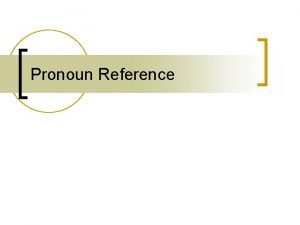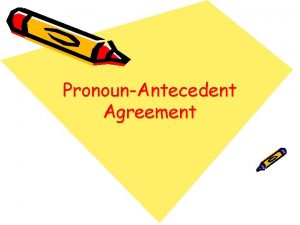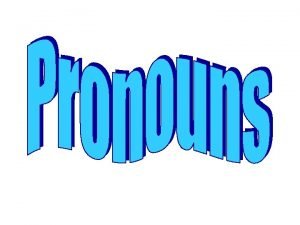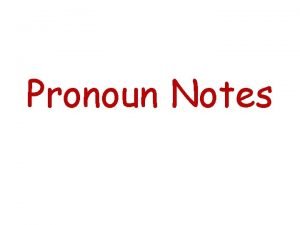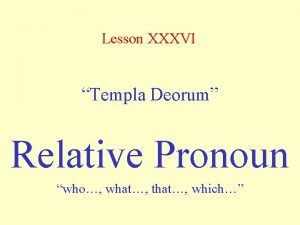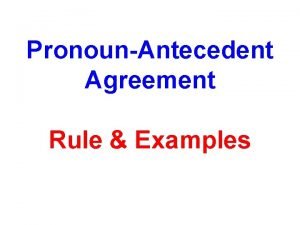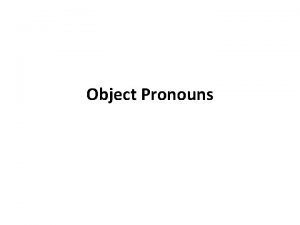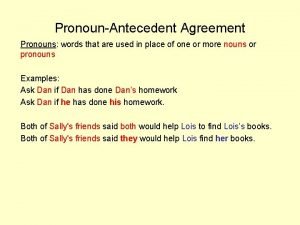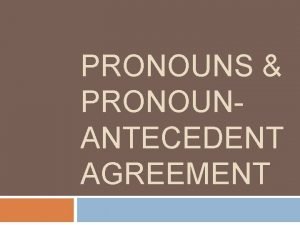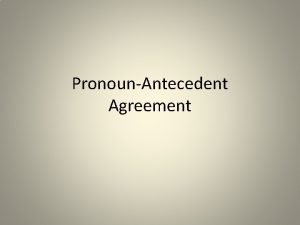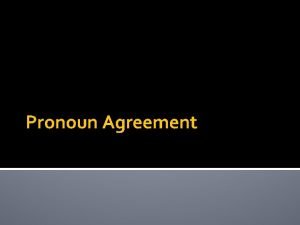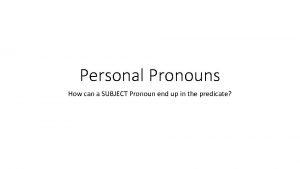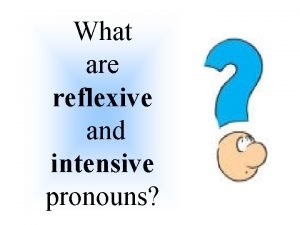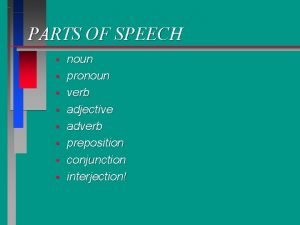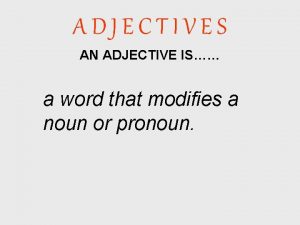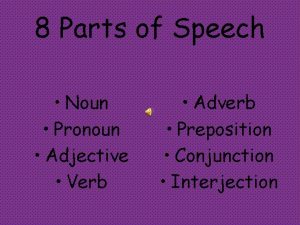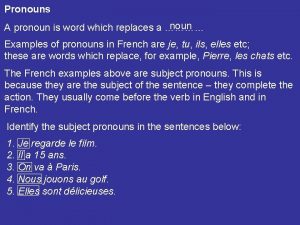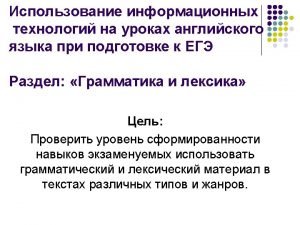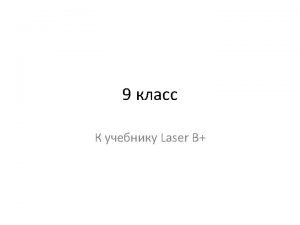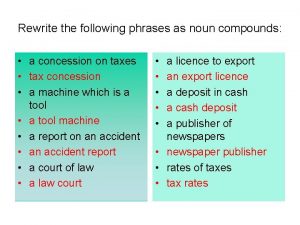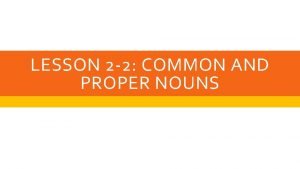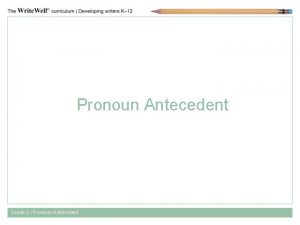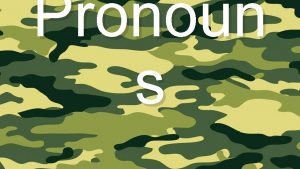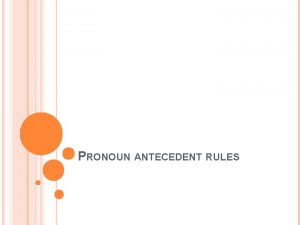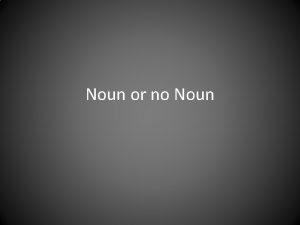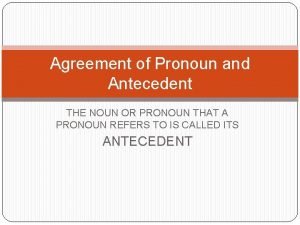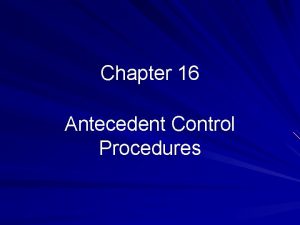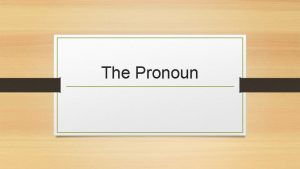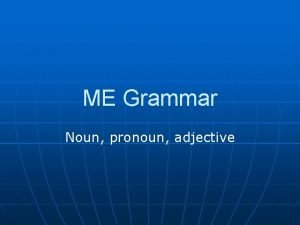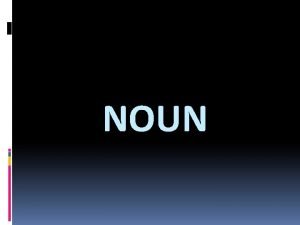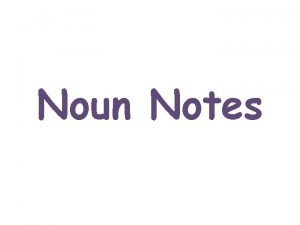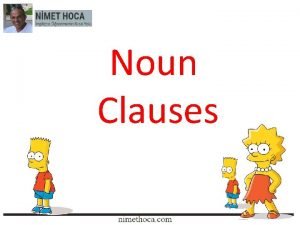Antecedent the noun or other pronoun that a













































- Slides: 45

Antecedent = the noun or other pronoun that a pronoun refers to. Pronouns and antecedents must agree.

Mary went to the store. She got apples, bananas, and oranges. She refers to Mary is the antecedent of the pronoun she.

Rule #1 – A pronoun should agree in gender with its antecedent. Feminine she hers Masculine he him his Neutral it its it

Examples Rosa said her lost her glasses. Hank took his journal to the beach with him. Manny chose that bike because of its color and style.

A. Sometimes the antecedent can be another pronoun. In that case, look in the rest of the sentence to see what gender to use. One of those ladies left her scarf in the car. Each of the boys brought his own softball mitt.

B. Sometimes the antecedent may be either masculine or feminine. In this case use both the masculine and feminine forms of the pronoun Nobody in the class finished his or her paper early.

C. It is incorrect grammar to refer to a singular antecedent with a plural pronoun. Incorrect: Every actor in the play had already memorized their lines. Correct: Every actor in the play had already memorized his or her lines.

Rule #2 – A pronoun should agree in number with its antecedent. A pronoun that refers to a singular antecedent should be singular. A pronoun that refers to a plural antecedent should be plural.

Examples Please put the mower away after using it. These tools will last longer if you take good care of them.

A. These indefinite pronouns are ALWAYS considered singular: anybody, anyone, anything, each, either, everybody, everyone, everything, neither, nobody, no one, nothing, one, somebody, someone, and something.

Examples • Has one of the hamsters hurt its leg? • Someone left his or her jacket on the bus. • Everyone on the girls’ team has her own locker.

These indefinite pronouns are always plural: both, few, many, and several. Examples: Both of the birds had hidden their nests. Several of the spiders continue to live under that log; it is where they hatched. On a night like this, few of the travelers will reach their destinations on schedule.

C. These indefinite pronouns can me SINGULAR or PLURAL depending on their meaning in the sentence: all, any, more, most, none, and some. None of the cereal has lost its crunch. None of the cereal flakes have lost their crunch.

D. Use a singular pronoun to refer to two or more singular antecedents joined by or or nor.

Examples • Either Miguel or Randall has his paintings on display. • Neither Karli nor Marta will lend you her book.

E. Use a plural pronoun to refer to two or more antecedents joined by and. When Tyrell and Davis get home, they will be surprised. Have Charles and Susan tried on their new outfits?

Exercise 11 1. Their should be its – two subjects joined by nor should be singular.

2. It should be them – the pronoun refers to tools which is plural

3. Her should be their – the pronoun refers to Mrs. Chin and her daughters so the pronoun should be plural

4. Their should be his or her – everyone is always singular so the pronoun must also be singular; we don’t know if everyone is male or female so we should use his or her to cover both genders

5. Its should be their – Many is always plural so the pronoun should be plural

6. Their should be his – the boys names are joined by nor so the pronoun should be singular; both names are boys names so the pronoun should be masculine.

7. Their should be its – one requires the pronoun to be singular; dog is neutral so the pronoun should be neutral in gender

8. Correct – song is singular and neutral so its is the correct pronoun to use.

9. Her should be their – the girls names are joined by and so a plural pronoun should be used

10. Its should be their – any can be singular or plural, but since the sentences says any of the horses, a plural pronoun is needed

Pronoun Case Notes

Subjective pronouns – these words take the place of nouns or other pronouns and work as the subject of a verb. The person or object referred to is doing the action.

Example 1. Diana asked herself where she could have put the book. She refers to _______, and she is the one who _____ the book somewhere.

Example 2. We helped ourselves to tacos and rice. We refers to the person talking and one or more other people. The speaker and the others are the ones who helped themselves to the food.

Objective pronouns – these words take the place of nouns or other pronouns and work as the object of a verb. The person or object referred to is receiving the action.

Example 1. Anthony will call her to get directions. Her refers to some female that Anthony will call. The girl is receiving the call, not making the call.

Example 2. Our family will take them to the fair. Them refers to another group of people that will ride with our family. The people being referred to will receive the action of being taken to the fair; the people referred to are not taking someone.

Possessive pronouns – these words take the place of nouns or other pronouns and show ownership or possession.

Example 1. Call your mother. Your is used to show that the mother belongs to the person being spoken to.

Example: 2. My aunt sold her car. Her is used to show that the car is owned by the speaker’s aunt.

• You are going to get three notecards. You will need to label them neatly and write fairly large • Label the first notecard- Subjective • Label the second notecard- Objective • Label the third notecard- Possessive You will be turning these cards in, please do not write your name on them

Use your hold up card to identify which type of pronoun is used in the sentence. Give the key to him.

She is the best choice.

My friend went to the beach.

Please tell my neighbor and him that we’ll walk the dogs next week.

The concert was thrilling for us in the audience.

The students finished all of their homework on time.

Choose a pronoun for each blank. 1. My cat ate all of ________ food this morning. 2. ______ brought a casserole to the potluck dinner and put it in the oven. 3. The doctor ordered the nurse to remove _______ bandages. 4. Didn’t you ask ______ not to do that? 5. That book is not the one ________ wanted to read.

Number and answer the following questions on notebook paper Write your name at the top!!! • Exit Slip 1. Which type of pronoun should be used in place of a noun or pronoun that is DOING an action in the sentence? ______________________ 2. Which type of pronoun should be used to show ownership in a sentence? __________ 3. Which type of pronoun should be used in place of a noun or pronoun that is RECEIVING an action in a sentence? _______________________________ Fill in the blank with an appropriate pronoun. 4. ______ like to go on field trips. 5. The student passed a paper back to __________. 6. ______ sweater was bright-blue.
 Personal pronouns
Personal pronouns Collective noun for cereal
Collective noun for cereal Pronoun-antecedent agreement examples
Pronoun-antecedent agreement examples Types of pronoun
Types of pronoun Antecedent
Antecedent Relative pronoun latin
Relative pronoun latin 10 rules on pronoun antecedents and agreement with examples
10 rules on pronoun antecedents and agreement with examples What is object pronouns
What is object pronouns Pronoun and antecedent
Pronoun and antecedent Antecedent agreement
Antecedent agreement Whose whom
Whose whom Redacted meaning
Redacted meaning Is they a singular pronoun
Is they a singular pronoun Define pronoun antecedent
Define pronoun antecedent Pronoun antecedent agreement meaning
Pronoun antecedent agreement meaning What is the basic principle of pronoun antecedent agreement
What is the basic principle of pronoun antecedent agreement What is the basic principle of pronoun antecedent agreement
What is the basic principle of pronoun antecedent agreement Italicized pronoun examples
Italicized pronoun examples Ind pronoun
Ind pronoun Chiến lược kinh doanh quốc tế của walmart
Chiến lược kinh doanh quốc tế của walmart Gây tê cơ vuông thắt lưng
Gây tê cơ vuông thắt lưng Block xoang nhĩ ecg
Block xoang nhĩ ecg Tìm độ lớn thật của tam giác abc
Tìm độ lớn thật của tam giác abc Sau thất bại ở hồ điển triệt
Sau thất bại ở hồ điển triệt Thể thơ truyền thống
Thể thơ truyền thống Con hãy đưa tay khi thấy người vấp ngã
Con hãy đưa tay khi thấy người vấp ngã Thơ thất ngôn tứ tuyệt đường luật
Thơ thất ngôn tứ tuyệt đường luật Tôn thất thuyết là ai
Tôn thất thuyết là ai Phân độ lown
Phân độ lown Interrogative and relative pronouns
Interrogative and relative pronouns Subject pronoun and predicate pronoun
Subject pronoun and predicate pronoun Subject pronoun and object pronoun
Subject pronoun and object pronoun Demonstrative indefinite interrogative pronouns worksheet
Demonstrative indefinite interrogative pronouns worksheet The meaning of reflexive pronoun
The meaning of reflexive pronoun Adjectives
Adjectives Noun pronoun adjective verb adverb
Noun pronoun adjective verb adverb Whats a coordinate adjective
Whats a coordinate adjective Noun pronoun adjective verb
Noun pronoun adjective verb Noun-pronoun agreement examples
Noun-pronoun agreement examples Complete the table verb noun damage
Complete the table verb noun damage 10 noun phrases
10 noun phrases Noun clause example
Noun clause example Caroline have a walkman
Caroline have a walkman Compound nouns
Compound nouns Takes the place of a noun or noun phrase
Takes the place of a noun or noun phrase Proper noun of subject
Proper noun of subject
